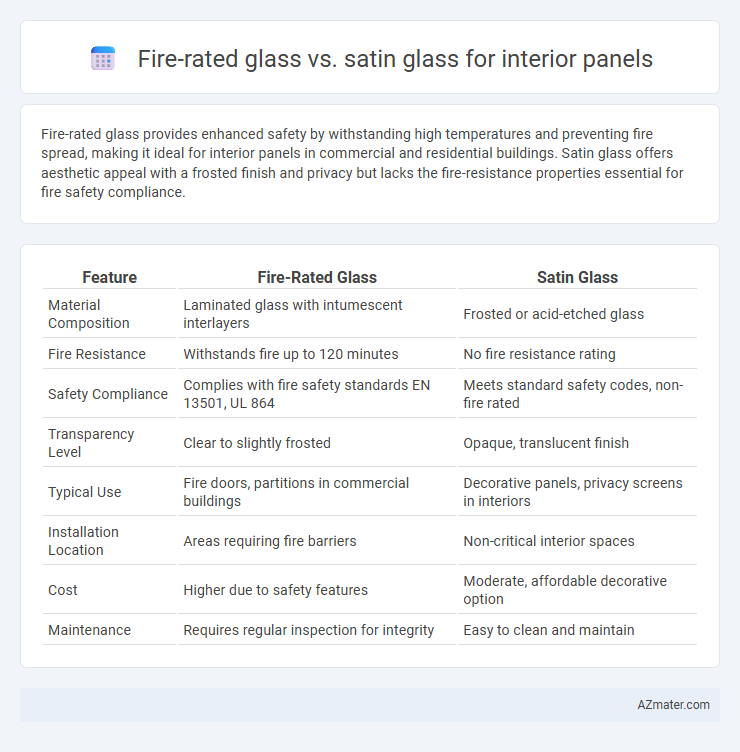Fire-rated glass provides enhanced safety by withstanding high temperatures and preventing fire spread, making it ideal for interior panels in commercial and residential buildings. Satin glass offers aesthetic appeal with a frosted finish and privacy but lacks the fire-resistance properties essential for fire safety compliance.
Table of Comparison
| Feature | Fire-Rated Glass | Satin Glass |
|---|---|---|
| Material Composition | Laminated glass with intumescent interlayers | Frosted or acid-etched glass |
| Fire Resistance | Withstands fire up to 120 minutes | No fire resistance rating |
| Safety Compliance | Complies with fire safety standards EN 13501, UL 864 | Meets standard safety codes, non-fire rated |
| Transparency Level | Clear to slightly frosted | Opaque, translucent finish |
| Typical Use | Fire doors, partitions in commercial buildings | Decorative panels, privacy screens in interiors |
| Installation Location | Areas requiring fire barriers | Non-critical interior spaces |
| Cost | Higher due to safety features | Moderate, affordable decorative option |
| Maintenance | Requires regular inspection for integrity | Easy to clean and maintain |
Understanding Fire-Rated Glass: Key Features and Benefits
Fire-rated glass offers essential protection by withstanding high temperatures and preventing the spread of flames and smoke in interior panels, making it crucial for enhancing building safety. Its multi-layered construction typically includes tempered glass and intumescent interlayers, which activate during fire incidents to maintain integrity and visibility while blocking heat transfer. Satin glass, while providing aesthetic appeal with its frosted, translucent finish, lacks fire resistance and is primarily used for privacy and decorative purposes rather than safety.
What Is Satin Glass? Characteristics and Common Uses
Satin glass is a type of textured glass that features a smooth, frosted surface achieved through acid etching or sandblasting, providing a soft, diffused appearance that enhances privacy without sacrificing light transmission. Its key characteristics include a non-reflective matte finish, resistance to fingerprints and smudges, and versatility in design applications. Common uses of satin glass in interior panels include office partitions, bathroom enclosures, and decorative wall panels where subtle light diffusion and visual privacy are essential.
Fire-Rated Glass vs Satin Glass: Safety Considerations
Fire-rated glass offers superior safety by providing heat resistance and preventing fire spread, making it ideal for interior panels requiring compliance with fire safety regulations. Satin glass, while aesthetically pleasing with its frosted finish, lacks fire-resistant properties and does not provide the same level of protection in fire scenarios. Choosing fire-rated glass ensures enhanced occupant safety and adherence to building codes compared to satin glass.
Aesthetic Comparison: Visual Impact in Interior Spaces
Fire-rated glass offers a clear, smooth surface that enhances natural light and maintains open sightlines, making it ideal for modern, minimalist interiors prioritizing safety without compromising style. Satin glass provides a frosted, translucent finish that diffuses light softly, creating a warm, privacy-enhancing ambiance suited for cozy or sophisticated environments. The choice between fire-rated and satin glass hinges on balancing transparency and safety with the desired mood and visual texture in interior panel design.
Durability and Maintenance: Which Glass Lasts Longer?
Fire-rated glass offers enhanced durability due to its ability to withstand high temperatures and prevent fire spread, making it ideal for safety-critical interior panels that require long-term reliability. Satin glass, while aesthetically pleasing with its frosted appearance, is less resistant to impact and heat, leading to potential scratches and discoloration over time that require more frequent maintenance. Fire-rated glass generally lasts longer with minimal upkeep compared to satin glass, which demands careful cleaning and may need replacement sooner in high-traffic areas.
Acoustic Performance: Sound Insulation Differences
Fire-rated glass offers superior sound insulation with dense, multi-layered construction that effectively dampens sound transmission, making it an excellent choice for interior panels requiring both fire safety and acoustic control. Satin glass, while providing privacy and a diffused light effect, typically has lower sound insulation properties due to its thinner and less complex structure. For projects prioritizing acoustic performance alongside fire resistance, fire-rated glass panels deliver enhanced noise reduction compared to satin glass options.
Privacy Solutions: How Each Glass Type Performs
Fire-rated glass offers robust safety features while maintaining clear visibility, making it less effective for privacy but essential in fire-resistant interior panels. Satin glass excels in providing diffuse light diffusion and obscured vision, enhancing privacy without compromising natural light flow in interior spaces. Choosing between fire-rated and satin glass depends on balancing privacy needs with fire safety compliance in interior panel applications.
Cost Analysis: Fire-Rated Glass vs Satin Glass
Fire-rated glass typically costs 2 to 3 times more than satin glass due to its specialized manufacturing process and enhanced safety features. Installation expenses are higher for fire-rated glass as it requires certified framing systems and compliance with fire safety regulations. Satin glass offers a budget-friendly option for interior panels with aesthetic appeal, but lacks the fire resistance properties critical in safety-conscious environments.
Installation Process: Challenges and Recommendations
Fire-rated glass installation demands precise sealing and integration with fire-rated frames to maintain integrity under heat, posing challenges like requiring certified installers and compliance with strict building codes. Satin glass, while easier to handle, necessitates careful alignment to achieve uniform opacity and avoid visible defects but generally has fewer regulatory constraints. Professionals recommend thorough site assessment, securing appropriate hardware for fire-rated glass, and employing precision tools for satin glass to ensure seamless, code-compliant installation.
Choosing the Right Glass for Your Interior Panels
Fire-rated glass offers enhanced safety by providing heat resistance and preventing the spread of flames, making it ideal for interior panels in high-risk areas like kitchens and stairwells. Satin glass, characterized by its frosted, translucent surface, excels in privacy and aesthetic appeal, suitable for office partitions and decorative panels. Selecting the right glass depends on balancing fire safety requirements with design preferences and functional needs of the interior space.

Infographic: Fire-rated glass vs Satin glass for Interior panel
 azmater.com
azmater.com